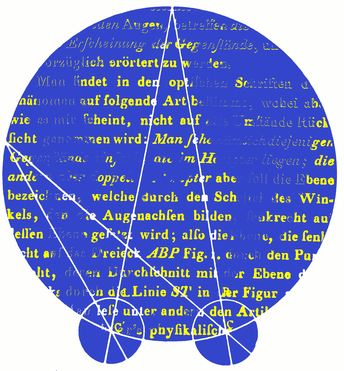Johannes Peter Müller1801–1858
Müller formulated a doctrine of specific nerve energies to account for the qualitative differences in experience provided by the senses. Like most doctrines this one was not new; Hunter and Bell had stated a similar principle, and it is implicit in Young’s trichromatic theory of colour vision. Nonetheless, it was enunciated in the greatest detail and with most authority by Müller in his Handbuch der Physiologie des Menschen (1833). The doctrine states that we are not directly aware of external objects, but only of the activity of our nerves, and that the five sensory nerves can each yield only a particular experience. “The nerve of each sense seems to be capable of one determinate kind of sensation only, and not of those proper to the other organs of sense; hence one nerve of sense cannot take the place and perform the functions of the nerve of another sense.” Müller’s Handbuch established him as the leading systematist and teacher of his day and was used as a standard text for decades. It brought together a wealth of detail about comparative anatomy and physiology, in addition to many original observations. It also united clinical practice with experimental physiology. Earlier, in 1826, Müller had published two books on vision: one on comparative physiology in which he gave detailed descriptions of binocular eye movements, and the other on subjective visual phenomena of the type described by Purkinje. A few years later he carried out experiments on frogs that established the Bell-Magendie law beyond dispute. Müller was born in Coblenz and studied medicine at the University of Bonn. In 1833 he was called to the chair of physiology at Berlin. Müller placed great emphasis on observation and thoroughness in conducting empirical research. Not surpisingly, he attracted the ablest students to Berlin, of whom Helmholtz, du Bois-Reymond, Brücke, Ludwig, Henle, Virchow and Schwann were some; these were to overturn the vitalism that Müller himself continued to believe in. Müller’s initial work on binocular vision was described in his studies on the comparative physiology of vision. Prior to the invention of the stereoscope it was considered that binocular single vision followed from stimulation of corresponding points on the two retinas. With binocular fixation on one point, the region of space at which corresponding retinal points will be stimulated is called the horopter. Gerhard Ulrich Anton Vieth (1763-1836) and Müller provided independent geometrical descriptions of the horopter, in 1818 and 1826, respectively, and it became known as the Vieth-Müller circle. The concept was introduced to English readers by Wheatstone. Müller’s portrait is embedded in text from Vieth’s paper, and both are enclosed within Wheatstone’s representation of the binocular circle.
